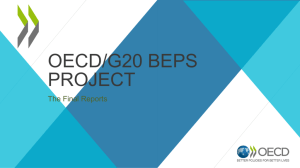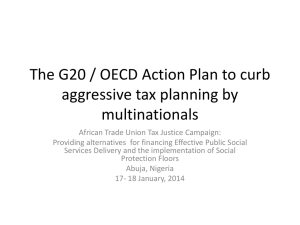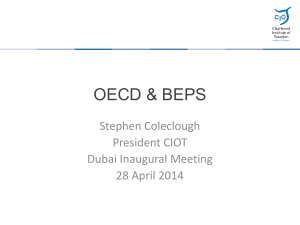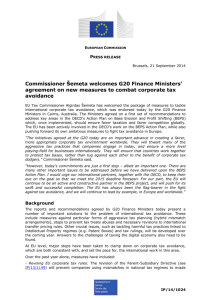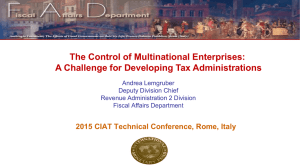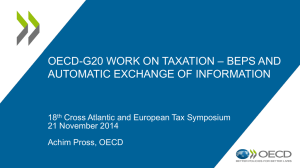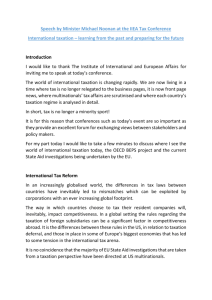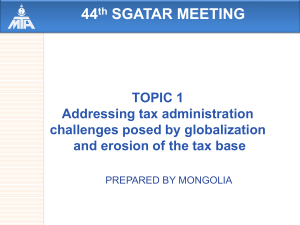BEPS MONITORING GROUP
advertisement
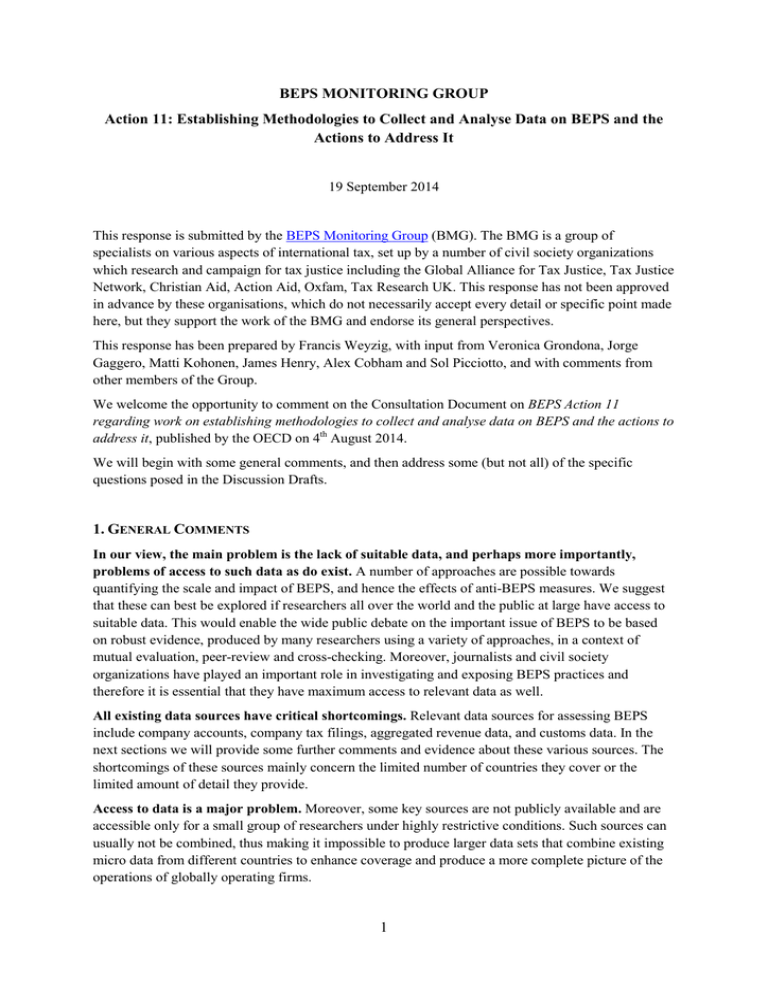
BEPS MONITORING GROUP Action 11: Establishing Methodologies to Collect and Analyse Data on BEPS and the Actions to Address It 19 September 2014 This response is submitted by the BEPS Monitoring Group (BMG). The BMG is a group of specialists on various aspects of international tax, set up by a number of civil society organizations which research and campaign for tax justice including the Global Alliance for Tax Justice, Tax Justice Network, Christian Aid, Action Aid, Oxfam, Tax Research UK. This response has not been approved in advance by these organisations, which do not necessarily accept every detail or specific point made here, but they support the work of the BMG and endorse its general perspectives. This response has been prepared by Francis Weyzig, with input from Veronica Grondona, Jorge Gaggero, Matti Kohonen, James Henry, Alex Cobham and Sol Picciotto, and with comments from other members of the Group. We welcome the opportunity to comment on the Consultation Document on BEPS Action 11 regarding work on establishing methodologies to collect and analyse data on BEPS and the actions to address it, published by the OECD on 4th August 2014. We will begin with some general comments, and then address some (but not all) of the specific questions posed in the Discussion Drafts. 1. GENERAL COMMENTS In our view, the main problem is the lack of suitable data, and perhaps more importantly, problems of access to such data as do exist. A number of approaches are possible towards quantifying the scale and impact of BEPS, and hence the effects of anti-BEPS measures. We suggest that these can best be explored if researchers all over the world and the public at large have access to suitable data. This would enable the wide public debate on the important issue of BEPS to be based on robust evidence, produced by many researchers using a variety of approaches, in a context of mutual evaluation, peer-review and cross-checking. Moreover, journalists and civil society organizations have played an important role in investigating and exposing BEPS practices and therefore it is essential that they have maximum access to relevant data as well. All existing data sources have critical shortcomings. Relevant data sources for assessing BEPS include company accounts, company tax filings, aggregated revenue data, and customs data. In the next sections we will provide some further comments and evidence about these various sources. The shortcomings of these sources mainly concern the limited number of countries they cover or the limited amount of detail they provide. Access to data is a major problem. Moreover, some key sources are not publicly available and are accessible only for a small group of researchers under highly restrictive conditions. Such sources can usually not be combined, thus making it impossible to produce larger data sets that combine existing micro data from different countries to enhance coverage and produce a more complete picture of the operations of globally operating firms. 1 Therefore we emphasise that the data generated by country-by-country reporting of multinational enterprises should become publicly available to enable research on BEPS. The modalities of data distribution are currently under development by the OECD as part of the BEPS project. The data from country-by-country reports will be the only source that covers all countries worldwide and provides comprehensive information on the total operations of globally operating firms. Moreover, these data will be collected on a common template and provide key information on both the location of economic activities and the location of profits and taxes. This will make the country-by-country data truly unique and very suitable to assess BEPS. If the data would not become publicly available, possibilities to assess BEPS and the effects of anti-BEPS measures would remain much more limited. If some countries unfortunately continue to block full publication of all firm-level country-bycountry data, the OECD should find alternative ways of making the data available for research and policy purposes. In our final section, we will elaborate on alternative options, such as publicly disclosing data aggregated at industry level and providing confidential data access to accredited researchers via a secured data system. We are not recommending specific methodologies at this stage. It is obviously important that any reports issued by inter-governmental organisations be based on methodologies widely accepted as sound. We suggest that the OECD team working on this subject should issue a consultation paper when they are in a position to make proposals on how they intend to proceed. We would be happy to comment on such a paper. In the meantime, in our view, the more important questions at this stage are availability of and access to data. 2. INDICATORS OF BEPS (QUESTION A) General indicators of BEPS include the locations where trade mark, patent and other intellectual property rights are registered and other measures of assets located in low-tax environments that may play a role in profit shifting strategies. Separate data on assets, capital flows and income of Special Purpose Entities (SPEs) could be a particularly relevant source. The OECD itself has defined SPEs in its 2008 manual concerning Foreign Direct Investments (FDI) where “SPEs are defined either by their structure (e.g., financing subsidiary, holding company, base company, regional headquarters), or their purpose (e.g., sale and regional administration, management of foreign exchange risk, facilitation of financing of investment).” Furthermore, SPEs are considered to have “few or no local operations”. The OECD highlights they are set up for other than direct investment purposes. Despite this clear rationale for separate reporting on SPEs, as recommended by the OECD, very few jurisdictions collect separate SPE-related company-level or macro-level data. It would be important to know both company-level information on when a company is classified as an SPE, and their aggregate income arising from their own operations, interest, royalties, dividends and management fees. This should be available via the Central Bank as is the case already on an aggregate level in the Netherlands and Luxembourg. Separately, it would be critical to know what share of FDI flows and positions, per industry and other FDI reporting categories arises from SPEs. This would be important to better assess treaty shopping, for example, and understand the related impact of FDI in both developing and developed economies (see e.g. Weyzig 2013). 2 3. ECONOMIC ANALYSIS OF BEPS (QUESTIONS B AND C) Financial Accounts – micro data Establishing accurate and consistent measures, to track over time and across countries, will be central to any effective monitoring of progress against BEPS. In the words of the Action Plan, this requires in particular “measures of the allocation of income across jurisdictions relative to measures of value creating activities”. In principle, micro data from company financial statements could be used to produce both types of measures. Company financial statements are commonly used in research on effective tax rates (ETR) (e.g. Markle & Shakelford 2012). Calculations of ETRs over time would be very relevant in calculating the impact of BEPS and effects of measures to combat it. However, this source is not very suitable because financial accounts state profits significantly differently from tax accounting standards. Company financial statements are also used in research on profit shifting through debt financing (e.g. Weyzig 2014, Buettner and Wamser 2007, Huizinga et al 2008). However, an important limitation in these studies is the limited country coverage and comparability across countries. At national level, from the ‘host’ economy side, some data are available on the domestic activities of multinationals (and of purely domestic firms, for comparison). Most typically, this involves balance sheet data from company registers. The data collected, and the data published, are not necessarily the same, and nor are they necessarily consistent across countries. As a result, they may be less useful in establishing international patterns. At national level again, but from the ‘home’ economy side, some countries collect and publish data on the global (FDI) activities of multinationals headquartered in their jurisdictions. Most well-known is the US BEA survey, which provides public access data on patterns of activity, aggregated at host economy and industry level. However, access to data relating to individual multinationals is only available to approved US citizens. Similar arrangements exist for broadly equivalent surveys of German- and Japanese-headquartered multinationals. The lack of broader coverage means that any analysis is inevitably distorted (e.g. research on US-headquartered multinationals may give a much more important role for profit-reporting to Bermuda than do those of Germany). Results from single national surveys (e.g. Cobham & Janský, forthcoming, using US data only) can show the broad contours – e.g. that lower-income, non-resource-based economies tend to see the biggest divergences between economic activity and tax base – but are of course unable to show the complete, global pattern. Obtaining the type of international data that would allow a full tracking of BEPS, and progress against it, is therefore problematic. This could in theory be achieved by combining national datasets of type (1) or type (2) in order to achieve a global picture. In practice, however, there are currently insufficient national FDI surveys to achieve broad global coverage in this way, and insufficient comparability and consistency of (published) balance sheet data to proceed in that way. Work with datasets that bring together national balance sheet and income account data (in which the private ORBIS database currently leads open sources such as OpenCorporates) demonstrates the weak coverage of developing countries in particular (see e.g. Cobham & Loretz, 2014) but also of some OECD countries, such a Germany (see Weyzig 2014). This is because data availability in larger datasets depends on underlying national sources. Financial information is not always publicly available, particularly in developing countries. Although local stock exchanges require public limited companies to present financial records, the size of such stock exchanges tends to be limited, mainly due to the fact that in many developing countries there is 3 a predominance of foreign controlled companies. According to an Interamerican Centre of Tax Administrations (CIAT – Centro Interamericano de Administraciones Financieras) 2013 report on availability of public information, in Argentina, Brazil, Chile, Costa Rica, Ecuador, Venezuela, Paraguay, Uruguay, the law regulating commercial societies requires such companies to register in a public registry. In Argentina and Chile, such requirements include the presentation of annual accounting records that should be publicly available. Such information could be used for the creation of financial micro data sets. However, in Argentina, access to this commercial public registry is limited due to a recent discussion on the interpretation of the law in terms of the level of public availability versus the level of data protection that should be granted. Thus data is currently not accessible despite the fact that public availability of this information should be granted for commercial transparency reasons.1 This leaves one obvious way forward: use of the consolidated and country-by-country reporting data, to be generated on the basis of the new OECD template, which should cover the operations of every multinational in every jurisdiction. It is our view that such data provides the only means to be able to meet the OECD commitment under BEPS Action Point 11, within any reasonable, foreseeable time horizon. Financial Accounts – macro data Several central banks, for example Argentina's Central Bank (BCRA), produce aggregate data that can be used to assess BEPS, such as data on intragroup loans. This data could be used in studies analysing the evolution of the use of intragroup financial mechanisms for base erosion and profit shifting. If produced by more central banks, such data could be used for a global study of the growth of such mechanisms and the consequences for different regions. In addition, trade in services by country is usually available (e.g. CEPALSTAT Database), with data segregated by royalty payments and entrepreneurial services, among others. Even when it is not available per trading partner, this information could also be considered for global studies on the growth of such payments and complement other studies on the use of such mechanisms for base erosion and profit shifting. However, the availability of macro data on financial accounts and trade in services and the level of detail differ between countries, restricting the suitability of such data for a comprehensive assessment of BEPS. Aggregate data such as the IMF’s Coordinated Direct Investment Survey lack sufficient detail to compare profit declaration with value creating activity, while UNCTAD data may lack robustness and is not fully comparable across countries. Tax Authority Data – micro data Regarding existing company data, a better source than financial statements would be tax returns themselves. Individual tax returns are generally regarded as confidential, although some have argued that at least for public companies there is no valid reason for this. In some countries, such as the US, researchers have been given access to the databases of revenue authorities under controlled conditions. Although this is a step forward, it is problematic if such access is limited and de facto discriminatory, since research outputs from such sources cannot be adequately cross-checked. 1 For more information in Spanish, see http://www.abogados.com.ar/acceso-a-la-informacion-en-la-inspecciongeneral-de-justicia/12792. 4 Moreover, it can only be used to assess BEPS by multinationals based in a very limited number of OECD countries. Tax Authority Data – macro data Tax returns, usually kept confidential by tax authorities, could be used in aggregated format, particularly for research relating to the effective tax rates paid by different industrial sectors and countries. In the same sense, some tax authorities, such as Argentina's, request companies to present special forms with information relating to transactions with related parties as well as with entities located in non-cooperative jurisdictions, and non-related parties, covering trade in goods: prices, volumes and trading partners. There should not be any obstacles for such data to be made available in aggregate form, both for research purposes and general public knowledge. Some Latin American countries share data extracted from these forms (e.g. effective tax rates, intragroup transactions, and transactions with parties located in tax havens) with international organizations, such as the CIAT, upon request, even if they are not shared with the public. This could mean that there are opportunities for such data on developing countries to be constructed by international organizations. Therefore, Action 11 constitutes an opportunity for the OECD to work on the creation of relevant aggregate data for monitoring and measuring the impact of BEPS in such countries. Customs Data – micro data Customs micro data is not available in many countries. In some countries, like the US, the information can be obtained with enough detail to compare the prices used by multinationals with related parties and non related parties, by country of destination, and product characteristics (see e.g. Bernard et al. 2006, Clausing 2003). According to the information gathered by the CIAT (2013) on Argentina, Brazil, Chile, Costa Rica, Ecuador, Guatemala, Panama, Paraguay, Uruguay and Venezuela, registers on importers and exporters, and the amounts traded per year, are available for public consultation in Argentina, Chile, and Uruguay. However, due to recent data protection discussions, in practice, micro data on Argentine trade is not accessible locally, though it is from private databases registered abroad (e.g. Penta Transactions). However, it does not allow for an analysis of prices and trade conditions between related and non related parties; though it does have information on product, prices, volumes, insurance and transport cost, and countries of destination. Customs Data – macro data In addition to micro data, aggregated data on bilateral trade in goods can also be used to analyse potential profit shifting through trade mispricing. This method is used by Cobham et al (2014), for example. The Comtrade database is the most commonly used source for such research. However, the Comtrade data are not always of high quality. For instance, there can be large discrepancies between the figures reported for exactly the same bilateral trade flow by the importing and exporting country. Moreover, no such database exists for trade in services. Tax Revenue Data Tax revenue data are macro-level figures that may overlap with aggregated tax authority data. Such macro data are generally used to estimate, for example, a ratio of corporate tax revenues relative to GDP. 5 Currently the limited availability of government revenue data is limiting the robust analysis of tax revenue trends and assessments of the tax base of developing countries.2 The IMF’s Government Finance Statistics (GFS) and World Bank's Global Development Indicators database does not collect consistent and comparable tax revenue information as it often either does not distinguish whether a country’s tax collection is from central government or from all levels of government (e.g. in the case of India). Somewhat more detailed data are available in the African Economic Outlook 2010 and 2014 tax surveys conducted together with the OECD and the African Development Bank (AfDB), or the Latin American Economic Outlook 2014 which includes data collected by the Economic Council for Latin America and the Caribbean (ECLAC). However, no similar regional database is available for developing nations in Asia, coverage for Latin American and African countries is far from complete, and for countries that are covered separate data for withholding tax revenues are often not available. This limits possibilities for a comprehensive assessment of trends in corporate tax revenues. An effort by the International Centre for Tax and Development (ICTD) at the Sussex University’s Institute for Development Studies (IDS) has combined the above-mentioned sources with additional data from IMF’s Article IV surveys into a comparable database, greatly improving data coverage across developing countries, while also drawing a clear distinction between resource and non-resource sources of tax revenue (Prichard et al. 2014). While not a substitute for long-term improvements in cross-country data collection by international organizations, it provides an immediately more complete basis for both research and policy analysis where developing countries are the focus. Separate data on corporate income tax revenues are available for many countries in the database, though not yet for all of them. 4. MAKING EFFECTIVE USE OF COUNTRY-BY-COUNTRY REPORTS (QUESTION D) As our general comments already emphasised, all existing data sources have serious limitations, while the better the data the more difficult it is for researchers to access. Hence, the data generated by country-by-country reporting of multinational enterprises should become publicly available to enable research on BEPS. Only if the data will be public would they be accessible for journalists and civil society organizations around the world, which have played and will continue to play an important role in investigating and exposing BEPS. Moreover, country-by-country data will help to inform the public debate on corporate tax. In a survey by PwC of 1,344 CEOs around the world, 59% of respondents agreed that multinationals should be required to publish key financial data on a countryby-country basis.3 Thus, a clear majority of multinationals themselves also supports publication requirements. Furthermore, publication of country-by-country data would be essential to identify in good time new BEPS problems, which may arise when the current action plans are being implemented. Without public data, tax authorities of individual countries may not be able to identify patterns in worldwide country-by-country data that point to new BEPS problems. Governments would also find it more difficult to develop targeted policy measures to address new BEPS problems if tax authorities cannot access the country-by-country data of individual firms. 2 See also the final communiqué of the Global Partnership for Effective Development Co-operation (GPEDC) in Mexico in April 2014. 3 See “CEOs back country-by-country tax reporting - survey”, Reuters, 13 Apr 2014, http://www.reuters.com/article/2014/04/23/taxcompanies-idUSL6N0NF2M920140423. 6 If some countries unfortunately continue to block full publication of all firm-level country-by-country data, the OECD should find alternative ways of making the data available for research and policy purposes. One way could be to aggregate data from all reporting firms worldwide by main industry classification and publicly disclose these data. Although this would be better than keeping the data secret, it would create some problems, e.g. in allocating some firms with varied business to particular sectors. A key lesson from the analytical work that has been done on the tax dodging practices employed by leading multinationals is that, at an industry level, they tend to adopt variations on the same basic practices. For example, since the late 1990s, leading players in the global pharmaceutical and software industries have become increasingly involved in transferring the ownership of "intellectual property" to low-tax jurisdictions at very low initial costs, and then paying royalties to their own subsidiaries in these jurisdictions. While there are interesting variations in the practices employed by these companies, at the industry level many of the practices, and indeed the jurisdictions they use, are very much the same. Similarly, in the case of global agribusiness (bananas, coffee, cereals and grains, etc.), similar practices have been developed to transfer key steps in the industry value chain to offshore low-tax jurisdictions, in many cases by establishing parent-owned service companies in low-tax jurisdictions like the BVI, Bermuda, or Cayman, and then selling management services, franchising, and financial services to the parent companies from these jurisdictions at prices that are very difficult to evaluate on the basis of arm’s-length criteria without extensive audits. The use of offshore intra-company debt to "asset strip" subsidiaries in higher-tax jurisdictions is another common industry practice, especially in capital intensive industries like shipping, autos, industrial goods, oil and gas, and utilities. Another method could be for the OECD to combine all country-by-country data reported by firms worldwide and provide confidential micro data access to accredited researchers via a secured data system. An example of an existing similar arrangement concerns the global financial database compiled by the Bank for International Settlements. This database combines confidential data from central banks and other sources all over the world. The full data set is not accessible even to the central banks reporting to the BIS. Only BIS researchers and accredited external researchers have access to the database, and as is usual with confidential micro datasets, research results can only be exported and published in a way that does not disclose confidential information about individual companies. We encourage the OECD to think of more ways and arrangements of making the country-by-country data available. Note that different ways of making the data available, such as publishing aggregated country-by-country data and providing access to micro data for accredited researchers, can complement each other. Therefore the OECD should aim to make the data available in various ways and formats. We emphasise once more that public availability of firm-level country-by-country data would offer many more possibilities for assessing BEPS than anything else. Alternative ways of making the data available may be a necessary but, we hope, temporary solution. Even though the OECD may not be in a position to recommend to all its members that data should be made publicly available, it could encourage individual members to introduce disclosure requirements at the national or regional level, building on initiatives such as the EU’s fourth capital requirements directive and the US Dodd-Frank Act. The existence of such requirements for specific sectors shows that there is no valid reason to regard this type of aggregate data as confidential. We understand that tax authorities are accustomed 7 to regarding tax returns as confidential. However, the data specific in the country-by-country reporting template proposed by the OECD in the report published this week is not of this type. It does not entail information that would normally be regarded as commercially confidential. It would be highly regrettable if simply because the template has been designed by tax officials the data supplied would be kept secret. 5. OTHER COMMENTS (QUESTION E) Strategic spillover effects of tax policy The IMF’s report concerning ‘spillover’ effects in international corporate taxation focused on two ‘spillover effects’ also known as fiscal externalities, first being a ‘base spillover’ where one country’s actions directly create an impact in other country’s Corporate Income Tax (CIT) base, while a second ‘strategic spillover’ induces directly or indirectly through investor or company pressure changes in other countries’ tax policies. The OECD BEPS project mainly discusses only the first type of ‘spillovers’, but fails to discuss the second type. It would be important to estimate the reduced policy space for developing countries in maintaining their desired set of corporate tax policies in a competitive environment. It would be important to know typical tax exemptions given to companies investing in both developing and developed countries and other possible reductions in effective corporate income tax rates that are beyond the nominal corporate income tax rates. Capital flight One way of estimating the fiscal damage of base erosion and profit shifting is through the analysis of capital flight. Capital flight has an effect on countries not only due to the movement of resources from developing countries to secrecy jurisdictions, but also due to the taxes that could not be collected in those countries where the profits were generated, as well as those that fail to be collected year after year on capital accumulated offshore; and the impact that such tax erosion has on infrastructure, health care, education, and general development possibilities. Therefore, Action 11 should also be an opportunity for generating data and methodologies that analyse and follow up on capital flight. Different estimations have been made in relation to capital flight and illicit flows in recent years. For example, Henry (2012) makes an estimation based on the Balance of Payments residual model, taking 139 key countries (low or medium income countries) and calculating annual flows of capital flight from all of them. In Argentina, Gaggero et al. (2013) performed an analysis on capital flight in 2013 (the third of a ten year programme that started in 2006), as well as an initial assessment of the relationship between capital flight and aggressive tax practices. The research by Gaggero et el. is based on the Balance of Payments residual model, taking the data for 1970-1998 from a paper on Argentina's capital flight written by Basualdo and Kulfas (2002) and for 1999-2012, from the Balance of Payments, though taking into account that this method underestimates capital flight when a debt restructuring takes place, such as the one Argentina had in 2005. Gaggero et. all follow Henry’s methodology, calculating the yield generated by such offshore investments, arriving in that way at a more realistic figure of capital flight. Global Financial Integrity (Kar 2013) has been monitoring global illicit financial flows through trade mispricing since a project by Baker, beginning with his book Capitalism's Achilles Heel (Baker 2005); their latest work being on Brazil’s illicit flows between 1960 and 2012 (Kar 2014) In addition to using the Balance of Payments residual model for licit capital flight, Global Financial Integrity estimates illicit capital flows using IMF's Trade Statistics, and uses the ‘gross excluding reversals’ 8 specification to compare at the national level the reported exports and imports with those recorded by all potential partners globally. REFERENCES Baker, R.W. (2005). Capitalism’s Achilles Heel: Dirty Money and How to Renew the Free-Market System. Hoboken, N.J.: John Wiley & Sons. Basualdo, E.M., & Kulfas, M. (2002). La fuga de capitales en la Argentina. In: CLASCO (Ed.) La Globalización Económico Financiera. Su impacto en América Latina. Buenos Aires. Bernard, A.B., Jensen, J.B., & Schott, P.K. (2006). Transfer Pricing by U.S.-Based Multinational Firms. (Working Paper Series No. 12493) National Bureau of Economic Research. Buettner, T., & Wamser, G. (2007). Intercompany loans and profit shifting – Evidence from companylevel data. (Working Paper Series No. 1959) CESifo. CIAT (2013), Disponibilidad de información pública de interés tributario en países de América Latina: Estado de Situación. Centro Interamericano de Administraciones Tributarias (CIAT). Clausing, K.A. (2003). Tax-motivated transfer pricing and US intrafirm trade. Journal of Public Economics 87(9-10), 2207-2223. Cobham, A., & Janský, P. (forthcoming). Misalignment between US multinational activity and profits, and the potential development impact of formulary apportionment. Cobham, P., Janský, P., & Prats, A. (2014). Estimating Illicit Flows of Capital via Trade Mispricing: A Forensic Analysis of Data on Switzerland. (Working paper 350) Center for Global Development. Cobham, A., & Loretz, S. (2014). International distribution of the corporate tax base: Impact of different apportionment factors under unitary taxation. Paper presented at the 70th Annual Congress of the International Institute of Public Finance, Lugano, 20-23, Aug 2014. Gaggero, J., Casparrino, C., & Libman, E. (2007). La Fuga de Capitales. Historia, Presente y Perspectivas. CEFID-AR. Documento de Trabajo Nª 14. Buenos Aires Gaggero, J., Kupelian, R., & Zelada, M.A. (2010). La Fuga de Capitales II Argentina en el escenario global (2002-2009). CEFID-AR. Documento de Trabajo Nª 29. Buenos Aires Gaggero, J., Rua, M., & Gaggero, A. (2013). Fuga de Capitales III. Argentina (2002-2012). Magnitudes, evolución, políticas públicas y cuestiones fiscales relevantes. CEFID-AR. Documento de Trabajo Nº 52. Buenos Aires. Gaggero, J., Rua, M., & Gaggero, A. (2014). The Offshore Assets of Argentines: Evolution of capital flight and relevant tax matters. FLACSO-ISA Conference, Buenos Aires. Henry, J.S. (2012). The Price of Offshore Revisited. Tax Justice Network. Huizinga, H., Laeven, L., & Nicodeme, G. (2008).Capital structure and international debt shifting. Journal of Financial Economics 88(1), 80-118. Kar, D., & LeBlanc, B. (2013). Illicit Financial Flows from Developing Countries: 2002-2011. Global Financial Integrity (GFI). Kar, D. (2014) Brasil: Fuga de Capitais, os Fluxos Ilícitos, e as Crises Macroeconômicas, 19602012. Global Financial Integrity (GFI). 9 Markle, K.S., & Shackelford, D.A. (2012). Cross-country comparisons of corporate income taxes. National Tax Journal, 65(3), 493–528. Prichard, W., Cobham, A., & Goodall, A. (2014). The ICTD Government Revenue Dataset. (Working Paper 19) ICTD. Weyzig, F. (2013). Tax treaty shopping: Structural determinants of Foreign Direct Investment routed through the Netherlands. International Tax and Public Finance 20(6), 910-937. Weyzig, F. (2014). The Capital Structure of Large Firms and the Use of Dutch Financing Entities. Fiscal Studies 35(2), 139-164. 10
